Toxicology Report: Asbestos Exposure, Health Risks and Management
VerifiedAdded on 2023/01/18
|11
|3258
|66
Report
AI Summary
This report provides a comprehensive overview of asbestos toxicology, encompassing its properties, sources, and the health hazards associated with exposure. It details the various types of asbestos minerals and their potential for causing diseases like asbestosis, lung cancer, and mesothelioma. The report delves into the mechanisms by which asbestos causes cancer, including the role of HMGB1 in promoting tumor growth. It also examines the exposure pathways, including ingestion through contaminated water and inhalation of airborne fibers. Furthermore, the report discusses management strategies, including global bans, the challenges of legacy asbestos in buildings, and the need for worker protection. It underscores the importance of alternative materials and international cooperation in mitigating the risks of asbestos-related diseases. The report concludes by emphasizing the need for sustainable development and ethical practices in addressing the ongoing issues related to asbestos exposure.

Paraphrase This Document
Need a fresh take? Get an instant paraphrase of this document with our AI Paraphraser
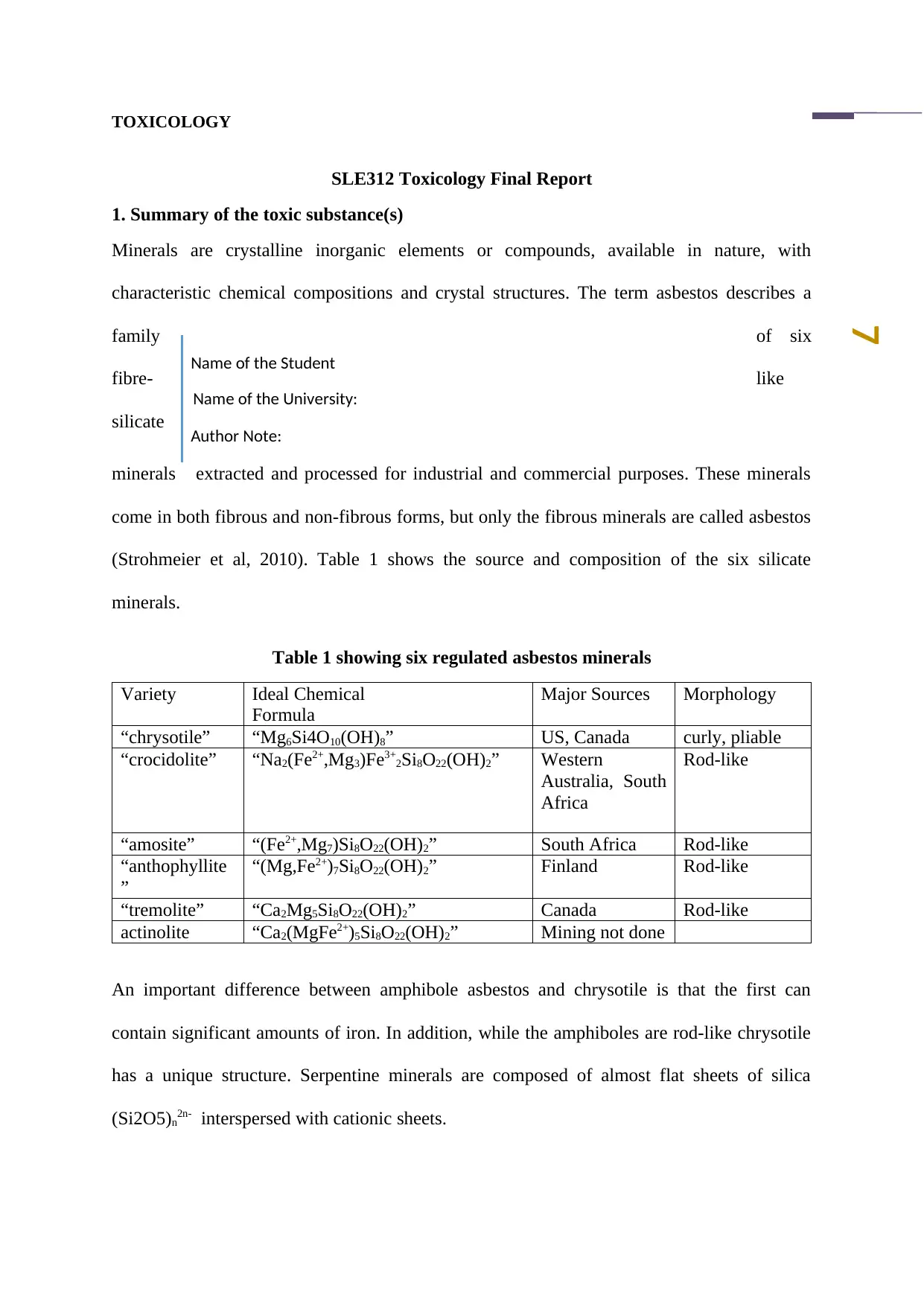
7
TOXICOLOGY
SLE312 Toxicology Final Report
1. Summary of the toxic substance(s)
Minerals are crystalline inorganic elements or compounds, available in nature, with
characteristic chemical compositions and crystal structures. The term asbestos describes a
family of six
fibre- like
silicate
minerals extracted and processed for industrial and commercial purposes. These minerals
come in both fibrous and non-fibrous forms, but only the fibrous minerals are called asbestos
(Strohmeier et al, 2010). Table 1 shows the source and composition of the six silicate
minerals.
Table 1 showing six regulated asbestos minerals
Variety Ideal Chemical
Formula
Major Sources Morphology
“chrysotile” “Mg6Si4O10(OH)8” US, Canada curly, pliable
“crocidolite” “Na2(Fe2+,Mg3)Fe3+2Si8O22(OH)2” Western
Australia, South
Africa
Rod-like
“amosite” “(Fe2+,Mg7)Si8O22(OH)2” South Africa Rod-like
“anthophyllite
”
“(Mg,Fe2+)7Si8O22(OH)2” Finland Rod-like
“tremolite” “Ca2Mg5Si8O22(OH)2” Canada Rod-like
actinolite “Ca2(MgFe2+)5Si8O22(OH)2” Mining not done
An important difference between amphibole asbestos and chrysotile is that the first can
contain significant amounts of iron. In addition, while the amphiboles are rod-like chrysotile
has a unique structure. Serpentine minerals are composed of almost flat sheets of silica
(Si2O5)n2n- interspersed with cationic sheets.
Name of the Student
Name of the University:
Author Note:
TOXICOLOGY
SLE312 Toxicology Final Report
1. Summary of the toxic substance(s)
Minerals are crystalline inorganic elements or compounds, available in nature, with
characteristic chemical compositions and crystal structures. The term asbestos describes a
family of six
fibre- like
silicate
minerals extracted and processed for industrial and commercial purposes. These minerals
come in both fibrous and non-fibrous forms, but only the fibrous minerals are called asbestos
(Strohmeier et al, 2010). Table 1 shows the source and composition of the six silicate
minerals.
Table 1 showing six regulated asbestos minerals
Variety Ideal Chemical
Formula
Major Sources Morphology
“chrysotile” “Mg6Si4O10(OH)8” US, Canada curly, pliable
“crocidolite” “Na2(Fe2+,Mg3)Fe3+2Si8O22(OH)2” Western
Australia, South
Africa
Rod-like
“amosite” “(Fe2+,Mg7)Si8O22(OH)2” South Africa Rod-like
“anthophyllite
”
“(Mg,Fe2+)7Si8O22(OH)2” Finland Rod-like
“tremolite” “Ca2Mg5Si8O22(OH)2” Canada Rod-like
actinolite “Ca2(MgFe2+)5Si8O22(OH)2” Mining not done
An important difference between amphibole asbestos and chrysotile is that the first can
contain significant amounts of iron. In addition, while the amphiboles are rod-like chrysotile
has a unique structure. Serpentine minerals are composed of almost flat sheets of silica
(Si2O5)n2n- interspersed with cationic sheets.
Name of the Student
Name of the University:
Author Note:
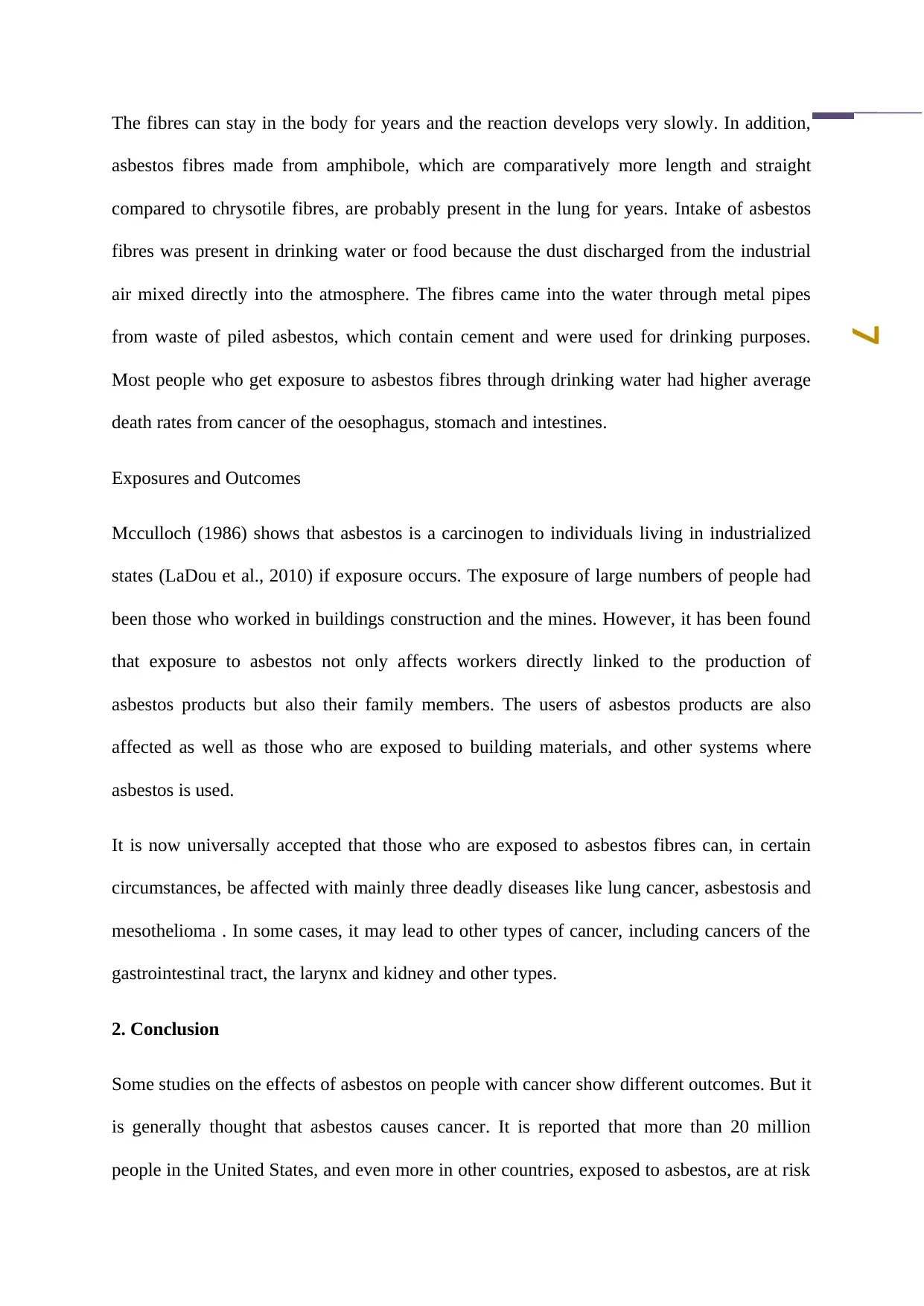
7
The fibres can stay in the body for years and the reaction develops very slowly. In addition,
asbestos fibres made from amphibole, which are comparatively more length and straight
compared to chrysotile fibres, are probably present in the lung for years. Intake of asbestos
fibres was present in drinking water or food because the dust discharged from the industrial
air mixed directly into the atmosphere. The fibres came into the water through metal pipes
from waste of piled asbestos, which contain cement and were used for drinking purposes.
Most people who get exposure to asbestos fibres through drinking water had higher average
death rates from cancer of the oesophagus, stomach and intestines.
Exposures and Outcomes
Mcculloch (1986) shows that asbestos is a carcinogen to individuals living in industrialized
states (LaDou et al., 2010) if exposure occurs. The exposure of large numbers of people had
been those who worked in buildings construction and the mines. However, it has been found
that exposure to asbestos not only affects workers directly linked to the production of
asbestos products but also their family members. The users of asbestos products are also
affected as well as those who are exposed to building materials, and other systems where
asbestos is used.
It is now universally accepted that those who are exposed to asbestos fibres can, in certain
circumstances, be affected with mainly three deadly diseases like lung cancer, asbestosis and
mesothelioma . In some cases, it may lead to other types of cancer, including cancers of the
gastrointestinal tract, the larynx and kidney and other types.
2. Conclusion
Some studies on the effects of asbestos on people with cancer show different outcomes. But it
is generally thought that asbestos causes cancer. It is reported that more than 20 million
people in the United States, and even more in other countries, exposed to asbestos, are at risk
The fibres can stay in the body for years and the reaction develops very slowly. In addition,
asbestos fibres made from amphibole, which are comparatively more length and straight
compared to chrysotile fibres, are probably present in the lung for years. Intake of asbestos
fibres was present in drinking water or food because the dust discharged from the industrial
air mixed directly into the atmosphere. The fibres came into the water through metal pipes
from waste of piled asbestos, which contain cement and were used for drinking purposes.
Most people who get exposure to asbestos fibres through drinking water had higher average
death rates from cancer of the oesophagus, stomach and intestines.
Exposures and Outcomes
Mcculloch (1986) shows that asbestos is a carcinogen to individuals living in industrialized
states (LaDou et al., 2010) if exposure occurs. The exposure of large numbers of people had
been those who worked in buildings construction and the mines. However, it has been found
that exposure to asbestos not only affects workers directly linked to the production of
asbestos products but also their family members. The users of asbestos products are also
affected as well as those who are exposed to building materials, and other systems where
asbestos is used.
It is now universally accepted that those who are exposed to asbestos fibres can, in certain
circumstances, be affected with mainly three deadly diseases like lung cancer, asbestosis and
mesothelioma . In some cases, it may lead to other types of cancer, including cancers of the
gastrointestinal tract, the larynx and kidney and other types.
2. Conclusion
Some studies on the effects of asbestos on people with cancer show different outcomes. But it
is generally thought that asbestos causes cancer. It is reported that more than 20 million
people in the United States, and even more in other countries, exposed to asbestos, are at risk
⊘ This is a preview!⊘
Do you want full access?
Subscribe today to unlock all pages.

Trusted by 1+ million students worldwide
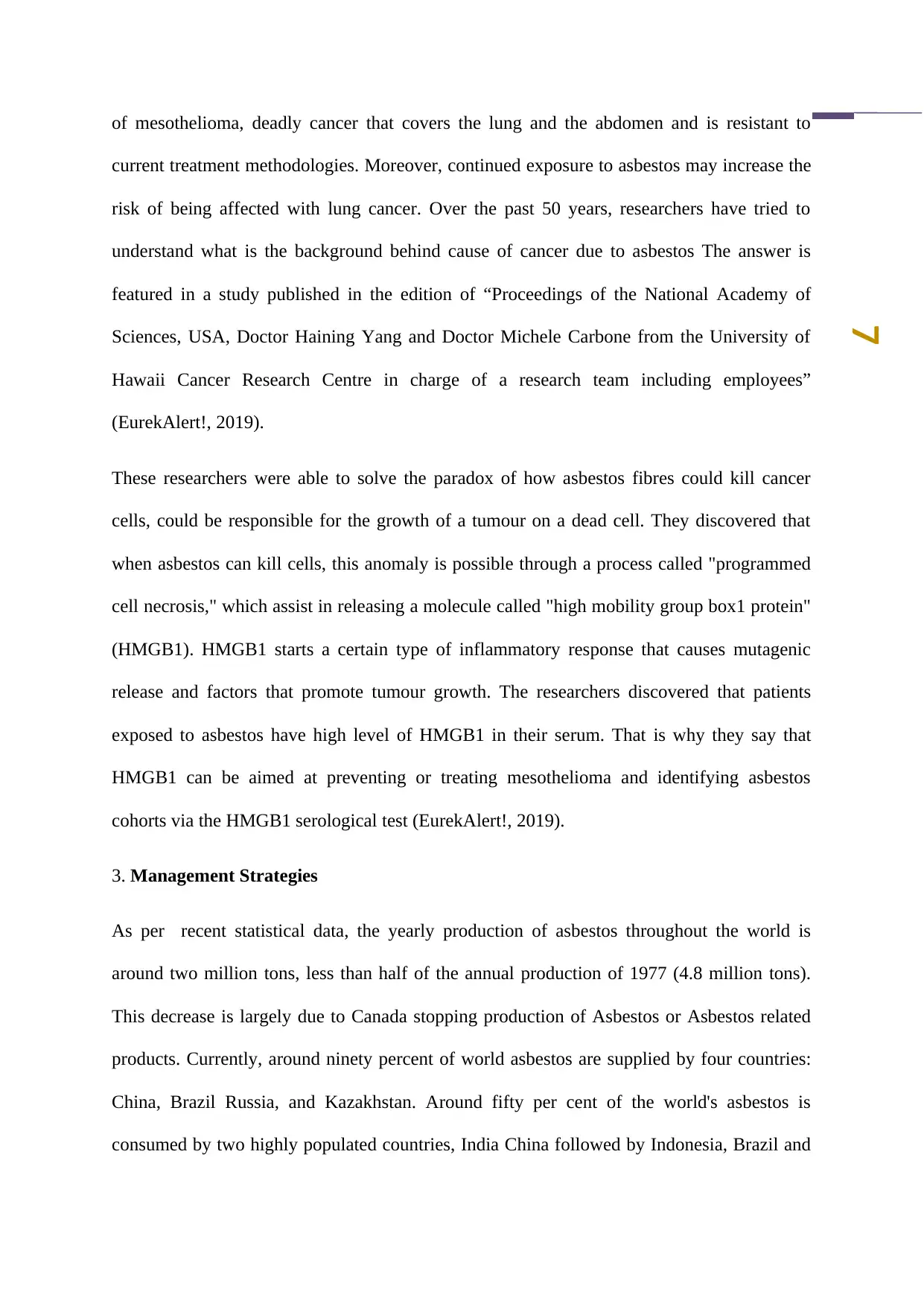
7
of mesothelioma, deadly cancer that covers the lung and the abdomen and is resistant to
current treatment methodologies. Moreover, continued exposure to asbestos may increase the
risk of being affected with lung cancer. Over the past 50 years, researchers have tried to
understand what is the background behind cause of cancer due to asbestos The answer is
featured in a study published in the edition of “Proceedings of the National Academy of
Sciences, USA, Doctor Haining Yang and Doctor Michele Carbone from the University of
Hawaii Cancer Research Centre in charge of a research team including employees”
(EurekAlert!, 2019).
These researchers were able to solve the paradox of how asbestos fibres could kill cancer
cells, could be responsible for the growth of a tumour on a dead cell. They discovered that
when asbestos can kill cells, this anomaly is possible through a process called "programmed
cell necrosis," which assist in releasing a molecule called "high mobility group box1 protein"
(HMGB1). HMGB1 starts a certain type of inflammatory response that causes mutagenic
release and factors that promote tumour growth. The researchers discovered that patients
exposed to asbestos have high level of HMGB1 in their serum. That is why they say that
HMGB1 can be aimed at preventing or treating mesothelioma and identifying asbestos
cohorts via the HMGB1 serological test (EurekAlert!, 2019).
3. Management Strategies
As per recent statistical data, the yearly production of asbestos throughout the world is
around two million tons, less than half of the annual production of 1977 (4.8 million tons).
This decrease is largely due to Canada stopping production of Asbestos or Asbestos related
products. Currently, around ninety percent of world asbestos are supplied by four countries:
China, Brazil Russia, and Kazakhstan. Around fifty per cent of the world's asbestos is
consumed by two highly populated countries, India China followed by Indonesia, Brazil and
of mesothelioma, deadly cancer that covers the lung and the abdomen and is resistant to
current treatment methodologies. Moreover, continued exposure to asbestos may increase the
risk of being affected with lung cancer. Over the past 50 years, researchers have tried to
understand what is the background behind cause of cancer due to asbestos The answer is
featured in a study published in the edition of “Proceedings of the National Academy of
Sciences, USA, Doctor Haining Yang and Doctor Michele Carbone from the University of
Hawaii Cancer Research Centre in charge of a research team including employees”
(EurekAlert!, 2019).
These researchers were able to solve the paradox of how asbestos fibres could kill cancer
cells, could be responsible for the growth of a tumour on a dead cell. They discovered that
when asbestos can kill cells, this anomaly is possible through a process called "programmed
cell necrosis," which assist in releasing a molecule called "high mobility group box1 protein"
(HMGB1). HMGB1 starts a certain type of inflammatory response that causes mutagenic
release and factors that promote tumour growth. The researchers discovered that patients
exposed to asbestos have high level of HMGB1 in their serum. That is why they say that
HMGB1 can be aimed at preventing or treating mesothelioma and identifying asbestos
cohorts via the HMGB1 serological test (EurekAlert!, 2019).
3. Management Strategies
As per recent statistical data, the yearly production of asbestos throughout the world is
around two million tons, less than half of the annual production of 1977 (4.8 million tons).
This decrease is largely due to Canada stopping production of Asbestos or Asbestos related
products. Currently, around ninety percent of world asbestos are supplied by four countries:
China, Brazil Russia, and Kazakhstan. Around fifty per cent of the world's asbestos is
consumed by two highly populated countries, India China followed by Indonesia, Brazil and
Paraphrase This Document
Need a fresh take? Get an instant paraphrase of this document with our AI Paraphraser
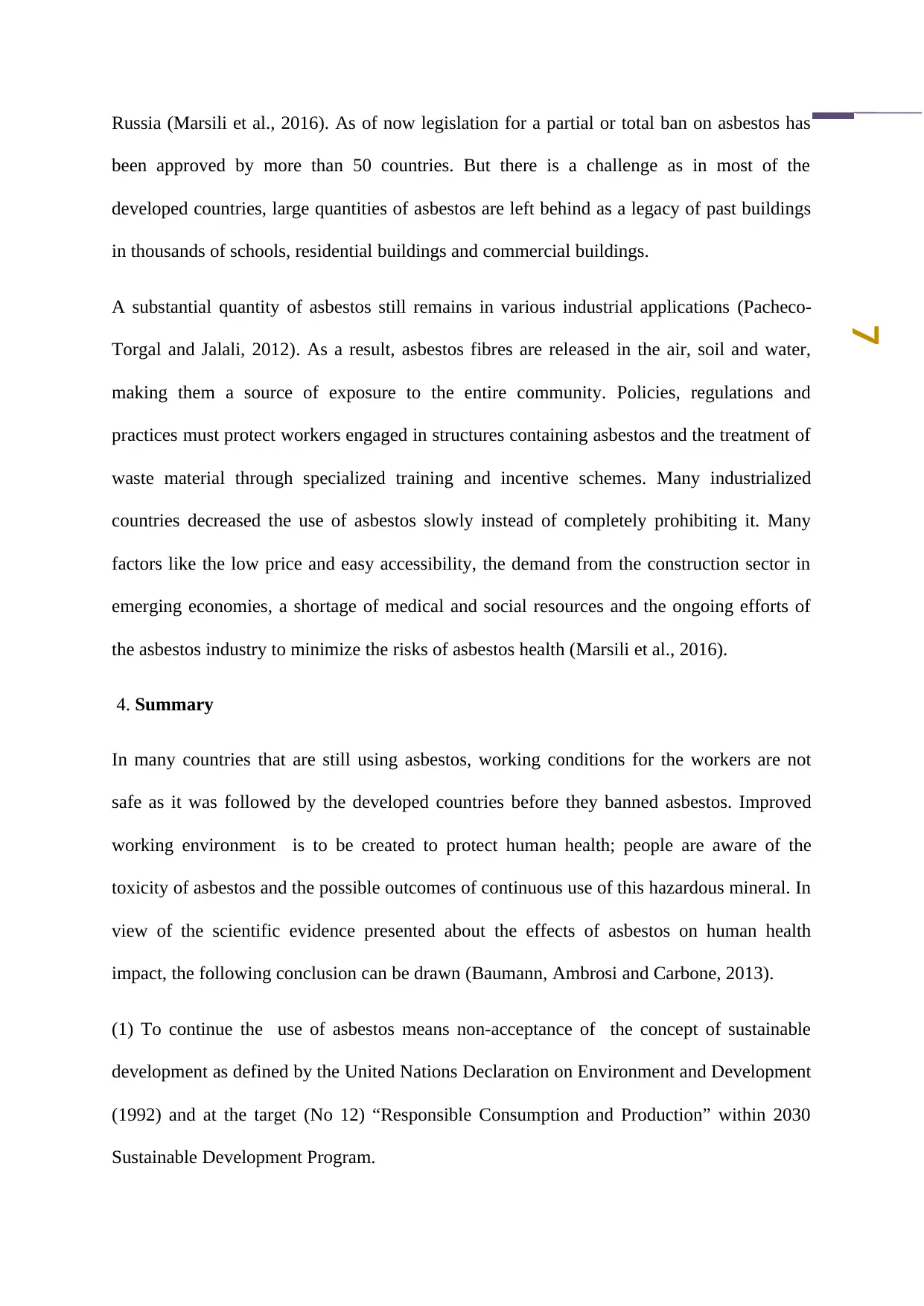
7
Russia (Marsili et al., 2016). As of now legislation for a partial or total ban on asbestos has
been approved by more than 50 countries. But there is a challenge as in most of the
developed countries, large quantities of asbestos are left behind as a legacy of past buildings
in thousands of schools, residential buildings and commercial buildings.
A substantial quantity of asbestos still remains in various industrial applications (Pacheco-
Torgal and Jalali, 2012). As a result, asbestos fibres are released in the air, soil and water,
making them a source of exposure to the entire community. Policies, regulations and
practices must protect workers engaged in structures containing asbestos and the treatment of
waste material through specialized training and incentive schemes. Many industrialized
countries decreased the use of asbestos slowly instead of completely prohibiting it. Many
factors like the low price and easy accessibility, the demand from the construction sector in
emerging economies, a shortage of medical and social resources and the ongoing efforts of
the asbestos industry to minimize the risks of asbestos health (Marsili et al., 2016).
4. Summary
In many countries that are still using asbestos, working conditions for the workers are not
safe as it was followed by the developed countries before they banned asbestos. Improved
working environment is to be created to protect human health; people are aware of the
toxicity of asbestos and the possible outcomes of continuous use of this hazardous mineral. In
view of the scientific evidence presented about the effects of asbestos on human health
impact, the following conclusion can be drawn (Baumann, Ambrosi and Carbone, 2013).
(1) To continue the use of asbestos means non-acceptance of the concept of sustainable
development as defined by the United Nations Declaration on Environment and Development
(1992) and at the target (No 12) “Responsible Consumption and Production” within 2030
Sustainable Development Program.
Russia (Marsili et al., 2016). As of now legislation for a partial or total ban on asbestos has
been approved by more than 50 countries. But there is a challenge as in most of the
developed countries, large quantities of asbestos are left behind as a legacy of past buildings
in thousands of schools, residential buildings and commercial buildings.
A substantial quantity of asbestos still remains in various industrial applications (Pacheco-
Torgal and Jalali, 2012). As a result, asbestos fibres are released in the air, soil and water,
making them a source of exposure to the entire community. Policies, regulations and
practices must protect workers engaged in structures containing asbestos and the treatment of
waste material through specialized training and incentive schemes. Many industrialized
countries decreased the use of asbestos slowly instead of completely prohibiting it. Many
factors like the low price and easy accessibility, the demand from the construction sector in
emerging economies, a shortage of medical and social resources and the ongoing efforts of
the asbestos industry to minimize the risks of asbestos health (Marsili et al., 2016).
4. Summary
In many countries that are still using asbestos, working conditions for the workers are not
safe as it was followed by the developed countries before they banned asbestos. Improved
working environment is to be created to protect human health; people are aware of the
toxicity of asbestos and the possible outcomes of continuous use of this hazardous mineral. In
view of the scientific evidence presented about the effects of asbestos on human health
impact, the following conclusion can be drawn (Baumann, Ambrosi and Carbone, 2013).
(1) To continue the use of asbestos means non-acceptance of the concept of sustainable
development as defined by the United Nations Declaration on Environment and Development
(1992) and at the target (No 12) “Responsible Consumption and Production” within 2030
Sustainable Development Program.
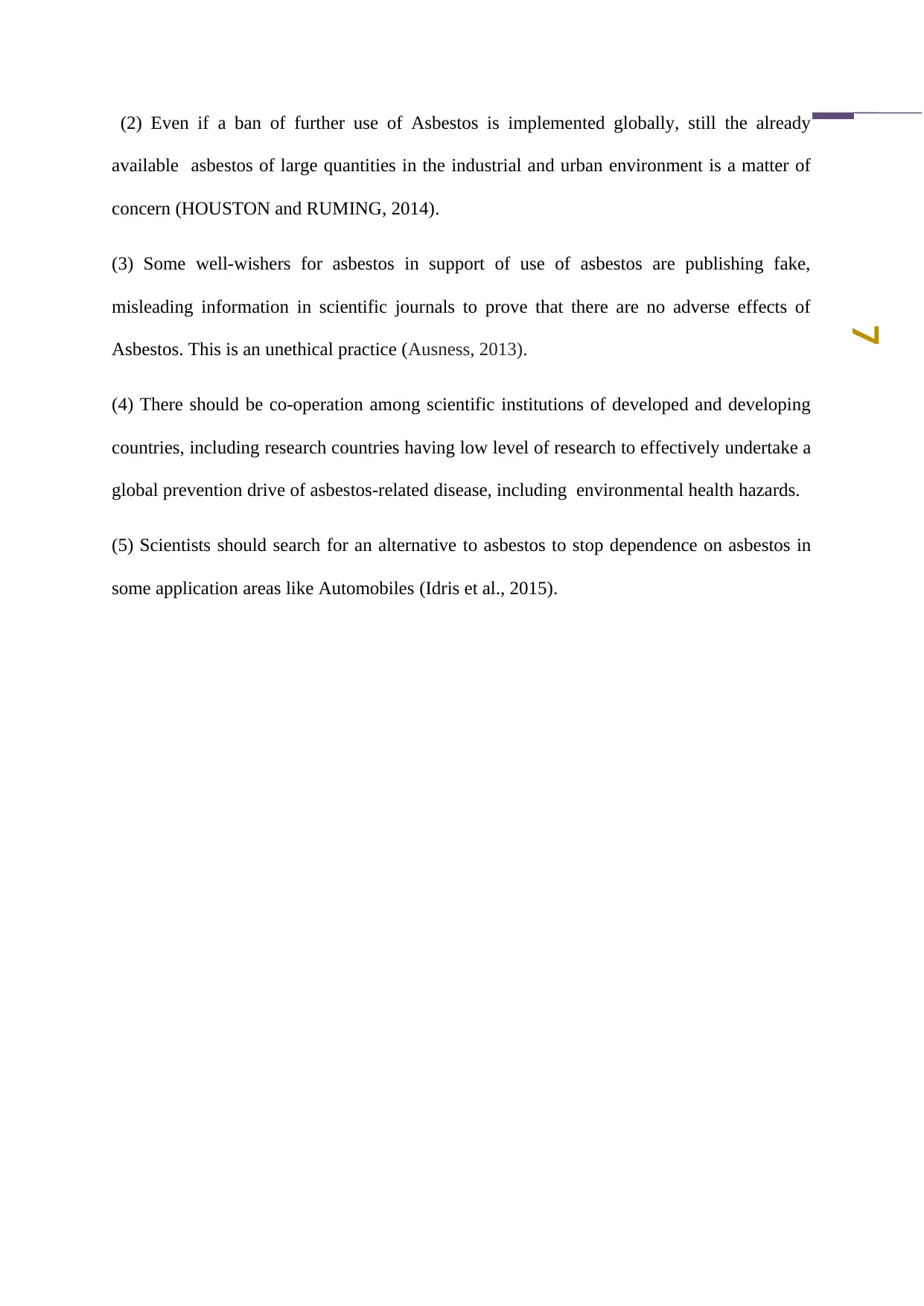
7
(2) Even if a ban of further use of Asbestos is implemented globally, still the already
available asbestos of large quantities in the industrial and urban environment is a matter of
concern (HOUSTON and RUMING, 2014).
(3) Some well-wishers for asbestos in support of use of asbestos are publishing fake,
misleading information in scientific journals to prove that there are no adverse effects of
Asbestos. This is an unethical practice (Ausness, 2013).
(4) There should be co-operation among scientific institutions of developed and developing
countries, including research countries having low level of research to effectively undertake a
global prevention drive of asbestos-related disease, including environmental health hazards.
(5) Scientists should search for an alternative to asbestos to stop dependence on asbestos in
some application areas like Automobiles (Idris et al., 2015).
(2) Even if a ban of further use of Asbestos is implemented globally, still the already
available asbestos of large quantities in the industrial and urban environment is a matter of
concern (HOUSTON and RUMING, 2014).
(3) Some well-wishers for asbestos in support of use of asbestos are publishing fake,
misleading information in scientific journals to prove that there are no adverse effects of
Asbestos. This is an unethical practice (Ausness, 2013).
(4) There should be co-operation among scientific institutions of developed and developing
countries, including research countries having low level of research to effectively undertake a
global prevention drive of asbestos-related disease, including environmental health hazards.
(5) Scientists should search for an alternative to asbestos to stop dependence on asbestos in
some application areas like Automobiles (Idris et al., 2015).
⊘ This is a preview!⊘
Do you want full access?
Subscribe today to unlock all pages.

Trusted by 1+ million students worldwide
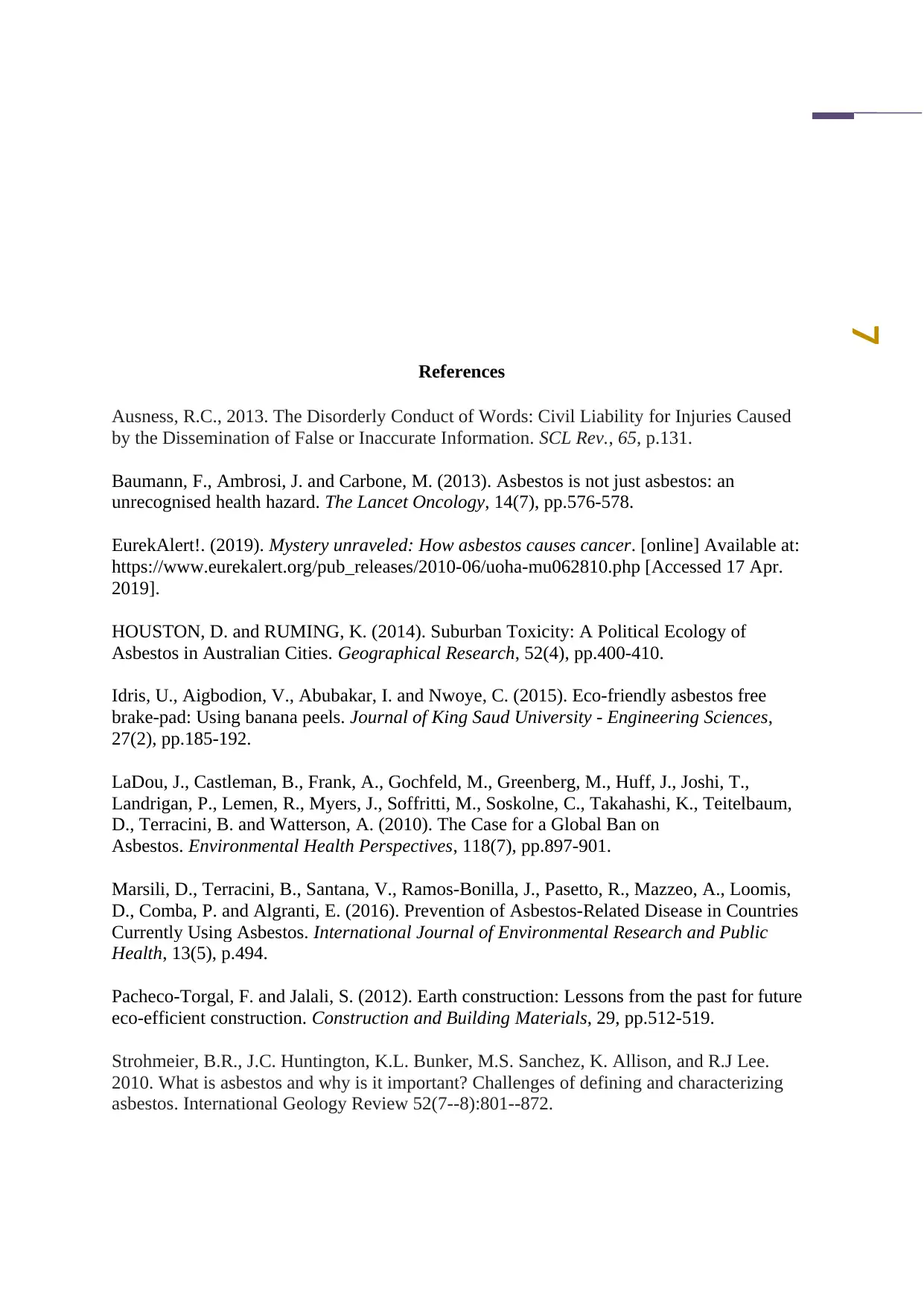
7
References
Ausness, R.C., 2013. The Disorderly Conduct of Words: Civil Liability for Injuries Caused
by the Dissemination of False or Inaccurate Information. SCL Rev., 65, p.131.
Baumann, F., Ambrosi, J. and Carbone, M. (2013). Asbestos is not just asbestos: an
unrecognised health hazard. The Lancet Oncology, 14(7), pp.576-578.
EurekAlert!. (2019). Mystery unraveled: How asbestos causes cancer. [online] Available at:
https://www.eurekalert.org/pub_releases/2010-06/uoha-mu062810.php [Accessed 17 Apr.
2019].
HOUSTON, D. and RUMING, K. (2014). Suburban Toxicity: A Political Ecology of
Asbestos in Australian Cities. Geographical Research, 52(4), pp.400-410.
Idris, U., Aigbodion, V., Abubakar, I. and Nwoye, C. (2015). Eco-friendly asbestos free
brake-pad: Using banana peels. Journal of King Saud University - Engineering Sciences,
27(2), pp.185-192.
LaDou, J., Castleman, B., Frank, A., Gochfeld, M., Greenberg, M., Huff, J., Joshi, T.,
Landrigan, P., Lemen, R., Myers, J., Soffritti, M., Soskolne, C., Takahashi, K., Teitelbaum,
D., Terracini, B. and Watterson, A. (2010). The Case for a Global Ban on
Asbestos. Environmental Health Perspectives, 118(7), pp.897-901.
Marsili, D., Terracini, B., Santana, V., Ramos-Bonilla, J., Pasetto, R., Mazzeo, A., Loomis,
D., Comba, P. and Algranti, E. (2016). Prevention of Asbestos-Related Disease in Countries
Currently Using Asbestos. International Journal of Environmental Research and Public
Health, 13(5), p.494.
Pacheco-Torgal, F. and Jalali, S. (2012). Earth construction: Lessons from the past for future
eco-efficient construction. Construction and Building Materials, 29, pp.512-519.
Strohmeier, B.R., J.C. Huntington, K.L. Bunker, M.S. Sanchez, K. Allison, and R.J Lee.
2010. What is asbestos and why is it important? Challenges of defining and characterizing
asbestos. International Geology Review 52(7-‐8):801-‐872.
References
Ausness, R.C., 2013. The Disorderly Conduct of Words: Civil Liability for Injuries Caused
by the Dissemination of False or Inaccurate Information. SCL Rev., 65, p.131.
Baumann, F., Ambrosi, J. and Carbone, M. (2013). Asbestos is not just asbestos: an
unrecognised health hazard. The Lancet Oncology, 14(7), pp.576-578.
EurekAlert!. (2019). Mystery unraveled: How asbestos causes cancer. [online] Available at:
https://www.eurekalert.org/pub_releases/2010-06/uoha-mu062810.php [Accessed 17 Apr.
2019].
HOUSTON, D. and RUMING, K. (2014). Suburban Toxicity: A Political Ecology of
Asbestos in Australian Cities. Geographical Research, 52(4), pp.400-410.
Idris, U., Aigbodion, V., Abubakar, I. and Nwoye, C. (2015). Eco-friendly asbestos free
brake-pad: Using banana peels. Journal of King Saud University - Engineering Sciences,
27(2), pp.185-192.
LaDou, J., Castleman, B., Frank, A., Gochfeld, M., Greenberg, M., Huff, J., Joshi, T.,
Landrigan, P., Lemen, R., Myers, J., Soffritti, M., Soskolne, C., Takahashi, K., Teitelbaum,
D., Terracini, B. and Watterson, A. (2010). The Case for a Global Ban on
Asbestos. Environmental Health Perspectives, 118(7), pp.897-901.
Marsili, D., Terracini, B., Santana, V., Ramos-Bonilla, J., Pasetto, R., Mazzeo, A., Loomis,
D., Comba, P. and Algranti, E. (2016). Prevention of Asbestos-Related Disease in Countries
Currently Using Asbestos. International Journal of Environmental Research and Public
Health, 13(5), p.494.
Pacheco-Torgal, F. and Jalali, S. (2012). Earth construction: Lessons from the past for future
eco-efficient construction. Construction and Building Materials, 29, pp.512-519.
Strohmeier, B.R., J.C. Huntington, K.L. Bunker, M.S. Sanchez, K. Allison, and R.J Lee.
2010. What is asbestos and why is it important? Challenges of defining and characterizing
asbestos. International Geology Review 52(7-‐8):801-‐872.
Paraphrase This Document
Need a fresh take? Get an instant paraphrase of this document with our AI Paraphraser
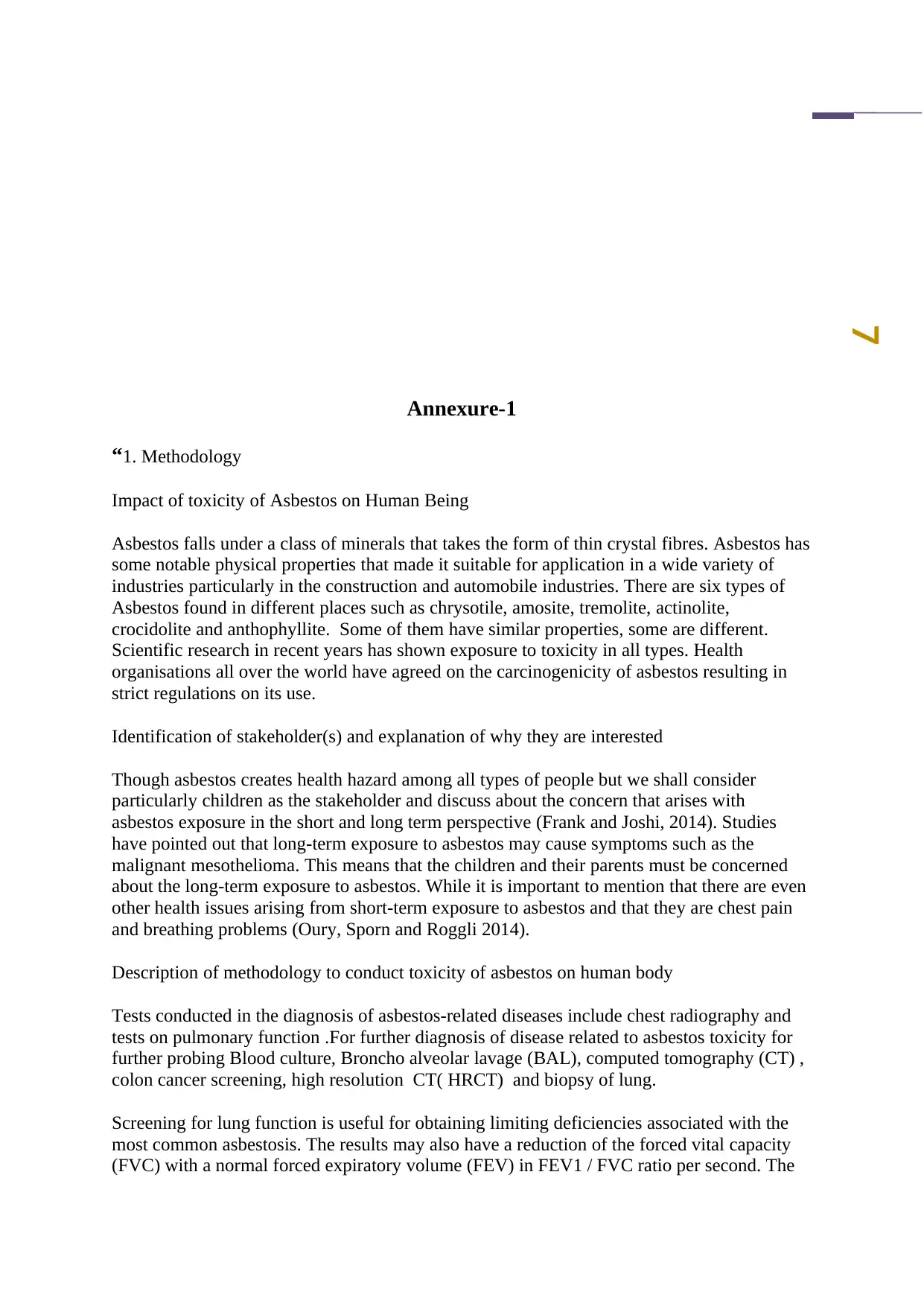
7
Annexure-1
“1. Methodology
Impact of toxicity of Asbestos on Human Being
Asbestos falls under a class of minerals that takes the form of thin crystal fibres. Asbestos has
some notable physical properties that made it suitable for application in a wide variety of
industries particularly in the construction and automobile industries. There are six types of
Asbestos found in different places such as chrysotile, amosite, tremolite, actinolite,
crocidolite and anthophyllite. Some of them have similar properties, some are different.
Scientific research in recent years has shown exposure to toxicity in all types. Health
organisations all over the world have agreed on the carcinogenicity of asbestos resulting in
strict regulations on its use.
Identification of stakeholder(s) and explanation of why they are interested
Though asbestos creates health hazard among all types of people but we shall consider
particularly children as the stakeholder and discuss about the concern that arises with
asbestos exposure in the short and long term perspective (Frank and Joshi, 2014). Studies
have pointed out that long-term exposure to asbestos may cause symptoms such as the
malignant mesothelioma. This means that the children and their parents must be concerned
about the long-term exposure to asbestos. While it is important to mention that there are even
other health issues arising from short-term exposure to asbestos and that they are chest pain
and breathing problems (Oury, Sporn and Roggli 2014).
Description of methodology to conduct toxicity of asbestos on human body
Tests conducted in the diagnosis of asbestos-related diseases include chest radiography and
tests on pulmonary function .For further diagnosis of disease related to asbestos toxicity for
further probing Blood culture, Broncho alveolar lavage (BAL), computed tomography (CT) ,
colon cancer screening, high resolution CT( HRCT) and biopsy of lung.
Screening for lung function is useful for obtaining limiting deficiencies associated with the
most common asbestosis. The results may also have a reduction of the forced vital capacity
(FVC) with a normal forced expiratory volume (FEV) in FEV1 / FVC ratio per second. The
Annexure-1
“1. Methodology
Impact of toxicity of Asbestos on Human Being
Asbestos falls under a class of minerals that takes the form of thin crystal fibres. Asbestos has
some notable physical properties that made it suitable for application in a wide variety of
industries particularly in the construction and automobile industries. There are six types of
Asbestos found in different places such as chrysotile, amosite, tremolite, actinolite,
crocidolite and anthophyllite. Some of them have similar properties, some are different.
Scientific research in recent years has shown exposure to toxicity in all types. Health
organisations all over the world have agreed on the carcinogenicity of asbestos resulting in
strict regulations on its use.
Identification of stakeholder(s) and explanation of why they are interested
Though asbestos creates health hazard among all types of people but we shall consider
particularly children as the stakeholder and discuss about the concern that arises with
asbestos exposure in the short and long term perspective (Frank and Joshi, 2014). Studies
have pointed out that long-term exposure to asbestos may cause symptoms such as the
malignant mesothelioma. This means that the children and their parents must be concerned
about the long-term exposure to asbestos. While it is important to mention that there are even
other health issues arising from short-term exposure to asbestos and that they are chest pain
and breathing problems (Oury, Sporn and Roggli 2014).
Description of methodology to conduct toxicity of asbestos on human body
Tests conducted in the diagnosis of asbestos-related diseases include chest radiography and
tests on pulmonary function .For further diagnosis of disease related to asbestos toxicity for
further probing Blood culture, Broncho alveolar lavage (BAL), computed tomography (CT) ,
colon cancer screening, high resolution CT( HRCT) and biopsy of lung.
Screening for lung function is useful for obtaining limiting deficiencies associated with the
most common asbestosis. The results may also have a reduction of the forced vital capacity
(FVC) with a normal forced expiratory volume (FEV) in FEV1 / FVC ratio per second. The
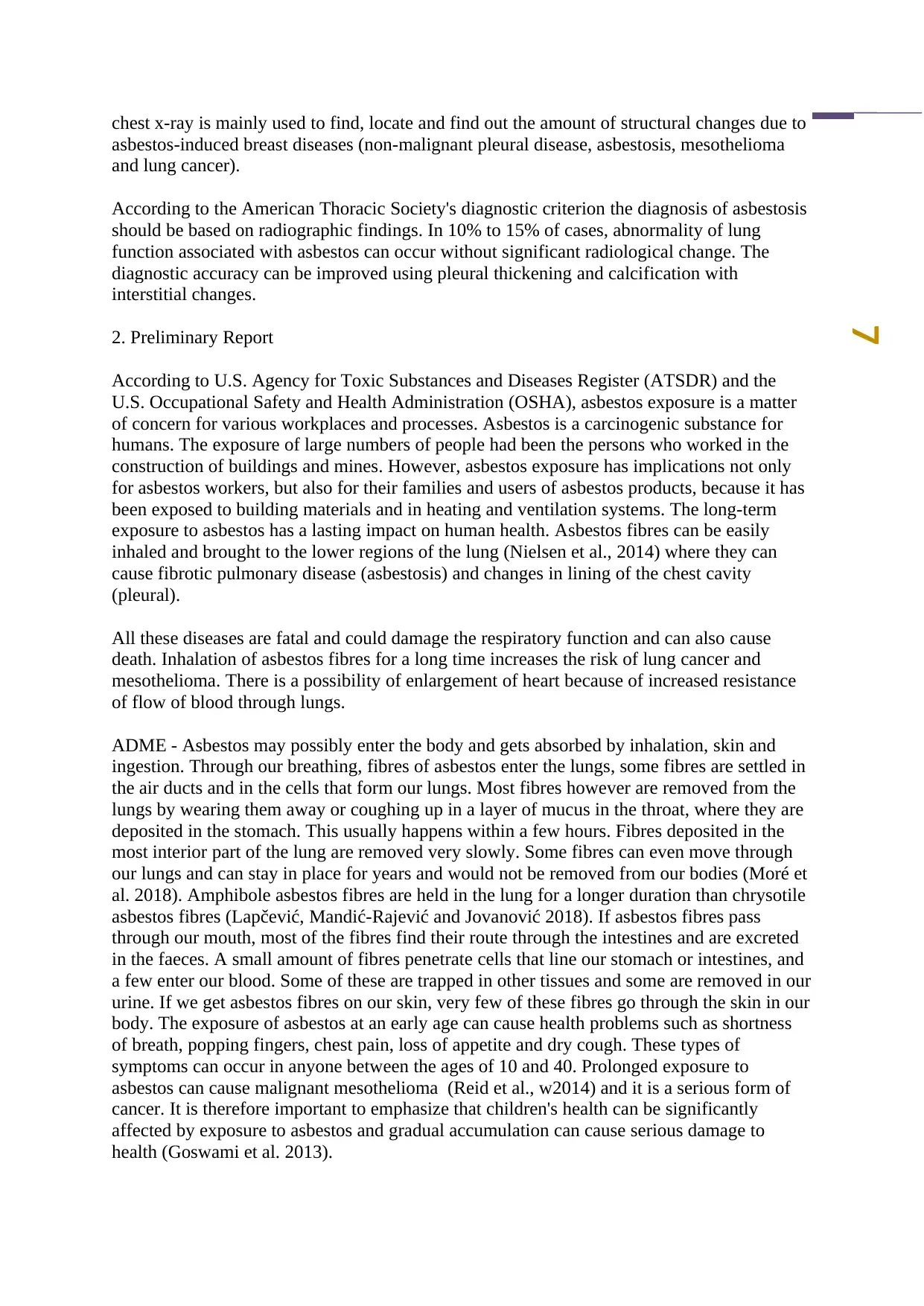
7
chest x-ray is mainly used to find, locate and find out the amount of structural changes due to
asbestos-induced breast diseases (non-malignant pleural disease, asbestosis, mesothelioma
and lung cancer).
According to the American Thoracic Society's diagnostic criterion the diagnosis of asbestosis
should be based on radiographic findings. In 10% to 15% of cases, abnormality of lung
function associated with asbestos can occur without significant radiological change. The
diagnostic accuracy can be improved using pleural thickening and calcification with
interstitial changes.
2. Preliminary Report
According to U.S. Agency for Toxic Substances and Diseases Register (ATSDR) and the
U.S. Occupational Safety and Health Administration (OSHA), asbestos exposure is a matter
of concern for various workplaces and processes. Asbestos is a carcinogenic substance for
humans. The exposure of large numbers of people had been the persons who worked in the
construction of buildings and mines. However, asbestos exposure has implications not only
for asbestos workers, but also for their families and users of asbestos products, because it has
been exposed to building materials and in heating and ventilation systems. The long-term
exposure to asbestos has a lasting impact on human health. Asbestos fibres can be easily
inhaled and brought to the lower regions of the lung (Nielsen et al., 2014) where they can
cause fibrotic pulmonary disease (asbestosis) and changes in lining of the chest cavity
(pleural).
All these diseases are fatal and could damage the respiratory function and can also cause
death. Inhalation of asbestos fibres for a long time increases the risk of lung cancer and
mesothelioma. There is a possibility of enlargement of heart because of increased resistance
of flow of blood through lungs.
ADME - Asbestos may possibly enter the body and gets absorbed by inhalation, skin and
ingestion. Through our breathing, fibres of asbestos enter the lungs, some fibres are settled in
the air ducts and in the cells that form our lungs. Most fibres however are removed from the
lungs by wearing them away or coughing up in a layer of mucus in the throat, where they are
deposited in the stomach. This usually happens within a few hours. Fibres deposited in the
most interior part of the lung are removed very slowly. Some fibres can even move through
our lungs and can stay in place for years and would not be removed from our bodies (Moré et
al. 2018). Amphibole asbestos fibres are held in the lung for a longer duration than chrysotile
asbestos fibres (Lapčević, Mandić-Rajević and Jovanović 2018). If asbestos fibres pass
through our mouth, most of the fibres find their route through the intestines and are excreted
in the faeces. A small amount of fibres penetrate cells that line our stomach or intestines, and
a few enter our blood. Some of these are trapped in other tissues and some are removed in our
urine. If we get asbestos fibres on our skin, very few of these fibres go through the skin in our
body. The exposure of asbestos at an early age can cause health problems such as shortness
of breath, popping fingers, chest pain, loss of appetite and dry cough. These types of
symptoms can occur in anyone between the ages of 10 and 40. Prolonged exposure to
asbestos can cause malignant mesothelioma (Reid et al., w2014) and it is a serious form of
cancer. It is therefore important to emphasize that children's health can be significantly
affected by exposure to asbestos and gradual accumulation can cause serious damage to
health (Goswami et al. 2013).
chest x-ray is mainly used to find, locate and find out the amount of structural changes due to
asbestos-induced breast diseases (non-malignant pleural disease, asbestosis, mesothelioma
and lung cancer).
According to the American Thoracic Society's diagnostic criterion the diagnosis of asbestosis
should be based on radiographic findings. In 10% to 15% of cases, abnormality of lung
function associated with asbestos can occur without significant radiological change. The
diagnostic accuracy can be improved using pleural thickening and calcification with
interstitial changes.
2. Preliminary Report
According to U.S. Agency for Toxic Substances and Diseases Register (ATSDR) and the
U.S. Occupational Safety and Health Administration (OSHA), asbestos exposure is a matter
of concern for various workplaces and processes. Asbestos is a carcinogenic substance for
humans. The exposure of large numbers of people had been the persons who worked in the
construction of buildings and mines. However, asbestos exposure has implications not only
for asbestos workers, but also for their families and users of asbestos products, because it has
been exposed to building materials and in heating and ventilation systems. The long-term
exposure to asbestos has a lasting impact on human health. Asbestos fibres can be easily
inhaled and brought to the lower regions of the lung (Nielsen et al., 2014) where they can
cause fibrotic pulmonary disease (asbestosis) and changes in lining of the chest cavity
(pleural).
All these diseases are fatal and could damage the respiratory function and can also cause
death. Inhalation of asbestos fibres for a long time increases the risk of lung cancer and
mesothelioma. There is a possibility of enlargement of heart because of increased resistance
of flow of blood through lungs.
ADME - Asbestos may possibly enter the body and gets absorbed by inhalation, skin and
ingestion. Through our breathing, fibres of asbestos enter the lungs, some fibres are settled in
the air ducts and in the cells that form our lungs. Most fibres however are removed from the
lungs by wearing them away or coughing up in a layer of mucus in the throat, where they are
deposited in the stomach. This usually happens within a few hours. Fibres deposited in the
most interior part of the lung are removed very slowly. Some fibres can even move through
our lungs and can stay in place for years and would not be removed from our bodies (Moré et
al. 2018). Amphibole asbestos fibres are held in the lung for a longer duration than chrysotile
asbestos fibres (Lapčević, Mandić-Rajević and Jovanović 2018). If asbestos fibres pass
through our mouth, most of the fibres find their route through the intestines and are excreted
in the faeces. A small amount of fibres penetrate cells that line our stomach or intestines, and
a few enter our blood. Some of these are trapped in other tissues and some are removed in our
urine. If we get asbestos fibres on our skin, very few of these fibres go through the skin in our
body. The exposure of asbestos at an early age can cause health problems such as shortness
of breath, popping fingers, chest pain, loss of appetite and dry cough. These types of
symptoms can occur in anyone between the ages of 10 and 40. Prolonged exposure to
asbestos can cause malignant mesothelioma (Reid et al., w2014) and it is a serious form of
cancer. It is therefore important to emphasize that children's health can be significantly
affected by exposure to asbestos and gradual accumulation can cause serious damage to
health (Goswami et al. 2013).
⊘ This is a preview!⊘
Do you want full access?
Subscribe today to unlock all pages.

Trusted by 1+ million students worldwide

7
References
Goswami, E., Craven, V., Dahlstrom, D., Alexander, D. and Mowat, F., 2013. Domestic
asbestos exposure: a review of epidemiologic and exposure data. International journal of
environmental research and public health, 10(11), pp.5629-5670.
Oury, T.D., Sporn, T.A. and Roggli, V.L. eds., 2014. Pathology of asbestos-associated
diseases (p. 357). Verlag Berlin Heidelberg: Springer.
Lapčević, Z., Mandić-Rajević, S. and Jovanović, M., 2018. The Use of Biological Monitoring
in Environmental Protection. Zbornik Međunarodnog kongresa o procesnoj industriji–
Procesing, 31(1), pp.217-222.
References
Goswami, E., Craven, V., Dahlstrom, D., Alexander, D. and Mowat, F., 2013. Domestic
asbestos exposure: a review of epidemiologic and exposure data. International journal of
environmental research and public health, 10(11), pp.5629-5670.
Oury, T.D., Sporn, T.A. and Roggli, V.L. eds., 2014. Pathology of asbestos-associated
diseases (p. 357). Verlag Berlin Heidelberg: Springer.
Lapčević, Z., Mandić-Rajević, S. and Jovanović, M., 2018. The Use of Biological Monitoring
in Environmental Protection. Zbornik Međunarodnog kongresa o procesnoj industriji–
Procesing, 31(1), pp.217-222.
Paraphrase This Document
Need a fresh take? Get an instant paraphrase of this document with our AI Paraphraser
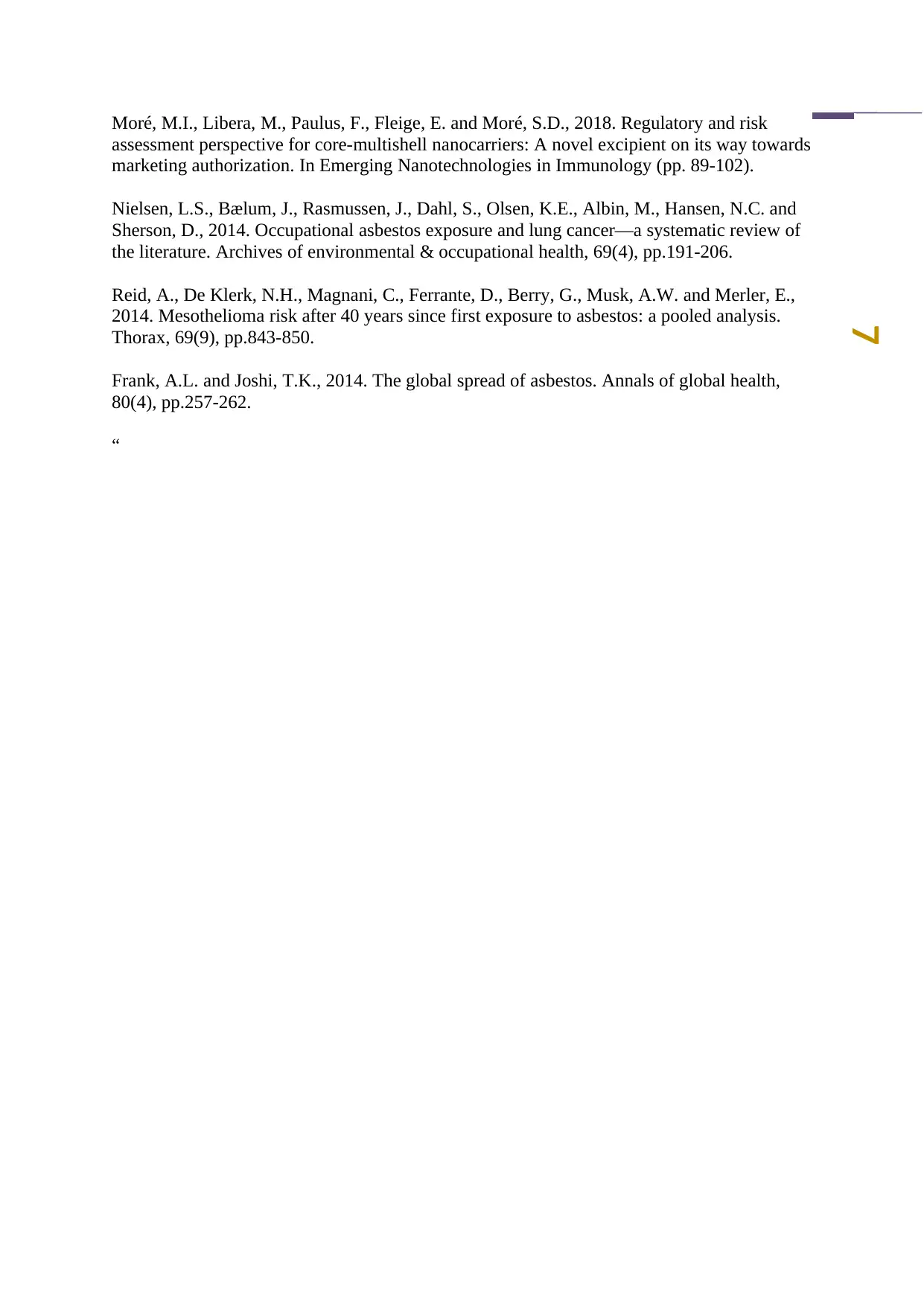
7
Moré, M.I., Libera, M., Paulus, F., Fleige, E. and Moré, S.D., 2018. Regulatory and risk
assessment perspective for core-multishell nanocarriers: A novel excipient on its way towards
marketing authorization. In Emerging Nanotechnologies in Immunology (pp. 89-102).
Nielsen, L.S., Bælum, J., Rasmussen, J., Dahl, S., Olsen, K.E., Albin, M., Hansen, N.C. and
Sherson, D., 2014. Occupational asbestos exposure and lung cancer—a systematic review of
the literature. Archives of environmental & occupational health, 69(4), pp.191-206.
Reid, A., De Klerk, N.H., Magnani, C., Ferrante, D., Berry, G., Musk, A.W. and Merler, E.,
2014. Mesothelioma risk after 40 years since first exposure to asbestos: a pooled analysis.
Thorax, 69(9), pp.843-850.
Frank, A.L. and Joshi, T.K., 2014. The global spread of asbestos. Annals of global health,
80(4), pp.257-262.
“
Moré, M.I., Libera, M., Paulus, F., Fleige, E. and Moré, S.D., 2018. Regulatory and risk
assessment perspective for core-multishell nanocarriers: A novel excipient on its way towards
marketing authorization. In Emerging Nanotechnologies in Immunology (pp. 89-102).
Nielsen, L.S., Bælum, J., Rasmussen, J., Dahl, S., Olsen, K.E., Albin, M., Hansen, N.C. and
Sherson, D., 2014. Occupational asbestos exposure and lung cancer—a systematic review of
the literature. Archives of environmental & occupational health, 69(4), pp.191-206.
Reid, A., De Klerk, N.H., Magnani, C., Ferrante, D., Berry, G., Musk, A.W. and Merler, E.,
2014. Mesothelioma risk after 40 years since first exposure to asbestos: a pooled analysis.
Thorax, 69(9), pp.843-850.
Frank, A.L. and Joshi, T.K., 2014. The global spread of asbestos. Annals of global health,
80(4), pp.257-262.
“
1 out of 11
Your All-in-One AI-Powered Toolkit for Academic Success.
+13062052269
info@desklib.com
Available 24*7 on WhatsApp / Email
![[object Object]](/_next/static/media/star-bottom.7253800d.svg)
Unlock your academic potential
Copyright © 2020–2025 A2Z Services. All Rights Reserved. Developed and managed by ZUCOL.